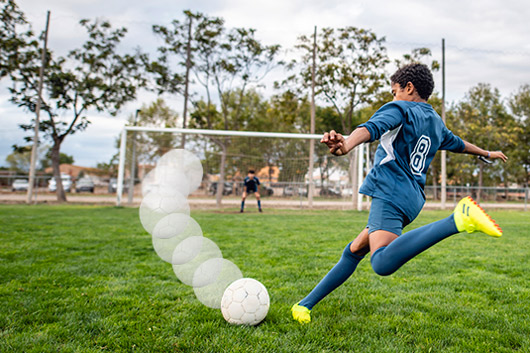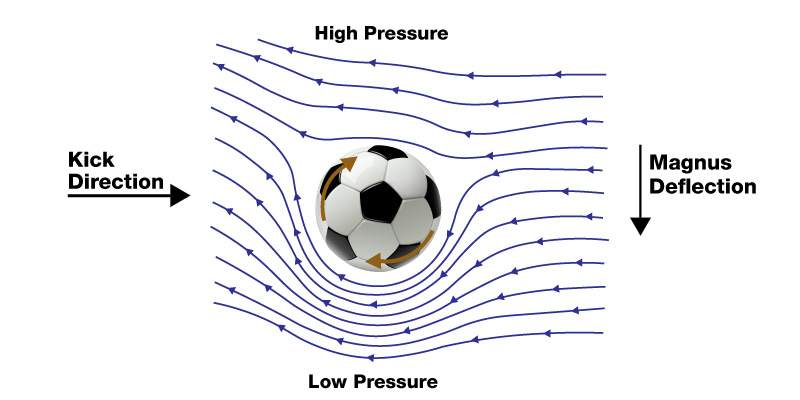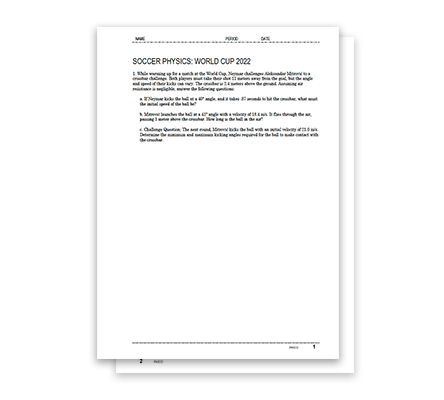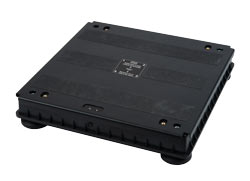Physics in Soccer: World Cup 2022

The 2022 World Cup has officially begun, and there’s never been a better time to explore the physics of soccer (or in Europe, football) with your students! From predicting the outcome of a crossbar challenge to understanding the science behind Ronaldo’s famous knuckleball free kick, physics plays an important role in determining which team rules the pitch.
Throughout the World Cup, we’ll be sharing soccer-themed content to help you bring the excitement of the World Cup into your physics course. In our first segment, we’ll explore the physics of soccer’s most infamous pre-match event: the crossbar challenge.
The Physics of Soccer: Crossbar Challenge
The crossbar challenge is a popular pre-game competition held between players from opposing teams. To compete, players take turns kicking soccer balls into the crossbar of a goal. The player who hits the crossbar the most wins the crossbar challenge. Seems simple enough, right? Well, not exactly!
In reality, the crossbar challenge is, well, challenging. The average player is lucky to land two of their five shots, which makes the five-for-five performances of superstars like Neymar Jr. all the more impressive. In fact, Neymar’s success in crossbar challenges is so repeatable that it begs the question: what is Neymar doing that other soccer players aren’t? (Check out this video to see Neymar demonstrate his technique in a crossbar challenge against two other professional soccer players.)
As it turns out, there is a secret to Neymar’s success: physics! When a player kicks a soccer ball, its landing position is largely determined by both the aerodynamics of the ball and the angle, direction, and velocity of the player’s kick. If we ignore aerodynamics for a moment (more on that later), then the crossbar challenge becomes a real-world example of projectile motion.
Incorporate the World Cup into your physics course with these soccer-themed projectile motion problems! Download the student worksheet for free below.
|
|
Celebrate the World Cup with these Soccer-Themed Practice Problems!Download the free Physics in Soccer student handout and answer key below. |
1. While warming up for a match at the World Cup, Neymar challenges Aleksandar Mitrović to a crossbar challenge. Both players must take their shot 11 meters away from the goal, but the angle and speed of their kicks can vary. The crossbar is 2.4 meters above the ground. Assuming air resistance is negligible, answer the following questions:
a. If Neymar kicks the ball at a 40° angle, and it takes .87 seconds to hit the crossbar, what must the initial speed of the ball be?
b. Mitrović launches the ball at a 41° angle with a velocity of 18.4 m/s. It flies through the air, passing 1 meter above the crossbar. How long is the ball in the air?
c. Challenge Question: The next round, Mitrović kicks the ball with an initial velocity of 21.0 m/s. Determine the minimum and maximum kicking angles required for the ball to make contact with the crossbar.
2. During a World Cup match, Lionel Messi kicks the ball at a 45° angle from ground level. It reaches a maximum height of 3.2 meters and lands 22.7 meters down the pitch. Assuming air resistance is negligible, answer the following questions:
a. What is the initial vertical velocity of the ball?
b. How long does it take for the soccer ball to reach the ground?
c. What is the initial horizontal velocity of the ball?
3. When the soccer ball leaves the field during a match, a corner kick is performed to restart the game. To perform a successful corner kick, the player must kick the ball at just the right angle, so that it bypasses opponents and lands near teammates. During a practice session for the World Cup, Cristiano Ronaldo makes a corner kick at a 42° angle, launching the soccer ball with an initial velocity of 26 m/s. Assuming the ball travels with projectile motion and air resistance is negligible, answer the following questions:
a. At what time does the soccer ball reach its peak height?
b. What is the maximum height reached by the soccer ball?
4. While practicing for the World Cup, Kylian Mbappé kicks the ball from the ground at a 41° angle. As the ball launches with an initial speed of 28.5 m/s, an opponent 54 meters away at the opposite side of the soccer field begins running to get the ball. What is the average speed he must maintain in order to make contact with the ball just before it hits the ground?
The Physics of Soccer: Peak Impact Force
Soccer balls have come a long way since the days of the classic black and white Telstar ball. Ball designs can vary by number of panels, seam depth, and even roughness, and it’s up to sports scientists to determine how these design decisions affect a soccer ball’s performance on the field.

One measurement used to assess the performance of a soccer ball is peak impact force. Peak impact force is the maximum force measured as the soccer ball impacts a surface. It is most often used to estimate the amount of force a player would experience when colliding with the ball. This is especially important in assessing the risk of concussion. If a ball produces a peak impact force that is too high, it could be a potential risk to players on the field.
We used Capstone Video Analysis and a Wireless Force Platform to complete our own soccer ball performance tests here at PASCO. Check out the video below to see how it went!
Collect and analyze your own force data with PASCO!
 |
PASCO Capstone
|
|
|
Wireless Force Platform (PS-3229)
|
This segment was inspired by a study published by Auger et al. which used a PASCO Force Platform to identify the effects of four soccer ball characteristics (size, inflation pressure, mass, velocity) on the resulting peak impact force.
The Physics of Soccer: Soccer Ball Spin
Retired professional soccer player, David Beckham, hasn’t participated in a World Cup since 2006, but his signature curved kicks continue to play out on fields around the world. What once was a unique skill set has since become a cornerstone of professional soccer, and part of what makes modern international superstars, like Lionel Messi, such competitive players. If you're a fan of the sport then you already know what a game-changer Beckham’s tactics can be. One moment the match is tied; the next, Beckham is bending the ball past the goalkeeper for the win. He seems to control how the ball curves. But how exactly does a player bend it like Beckham?

When a player lands a kick on the center of the ball, it follows a relatively straight path forward. But when the ball is kicked off-center, something interesting happens. Unbalanced forces act on the ball, causing it to spin through the air. As the ball spins, its path begins to curve – a phenomenon known as the Magnus Effect.
Magnus Effect
The Magnus Effect is caused by differences in air pressure on either side of the spinning ball. While in motion, one side of the ball spins in the direction of the airflow, causing the air that surrounds that side to travel more quickly, relative to the ball’s center. This results in reduced pressure, according to Bernoulli’s principle. On the other side of the ball, the direction of the spin opposes the direction of the airflow, causing the surrounding air to move more slowly. This imbalance of forces is what causes the ball’s path to curve in flight. The amount of curve on the ball’s trajectory is determined by the speed and direction of the spin.

Lift Force and Drag Force
There are primarily two forces that act on a spinning ball in flight: a lift force and a drag force. The lift force acts in the upwards or sideways direction, resulting in the Magnus effect. The drag force acts in the direction opposite to the ball’s flight path. This force tends to slow the ball down and decrease its speed. The magnitude of the drag force depends on several factors, including the ball’s size and shape, the ball’s pressure, and the velocity of the ball. For a spinning ball, the direction and magnitude of the drag force also depend on the ball’s spin rate and the orientation of the ball’s spin axis relative to the direction of motion.
File Attachments
| Physics in Soccer: Projectile Motion Problems - Student V | File Size: 81.32 KB | |
| Physics in Soccer: Projectile Motion Problems - Editable | File Size: 37.64 KB | |
| Physics in Soccer: Projectile Motion Problems - Answer Key | File Size: 55.11 KB |


